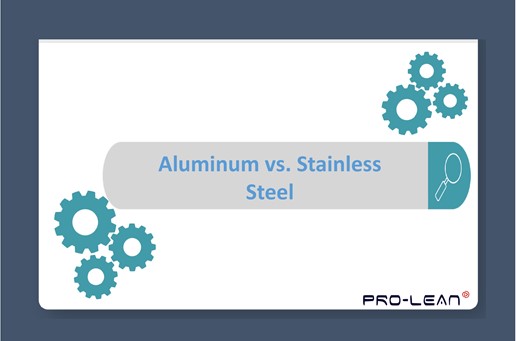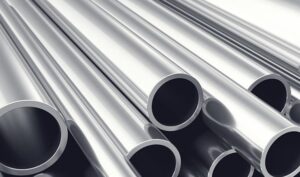Aluminum vs Stainless Steel: What You Need to Know

While aluminum and stainless steel look alike, they differ in properties and functions. Stainless steel is prominent in structures and household items, and aluminum suits areas such as cars and aircraft.
So, which of the two do you need? Strength, weldability, malleability, and corrosion resistance are some considerations.
Let’s delve more deeply into the aluminum vs. stainless steel debate, highlighting the properties and uses, among other things.
Is aluminum suitable for you?

Aluminum is a shiny silver-white metal. It is lightweight, corrosion-resistant, malleable, and electrically conductive. This versatile metal is common in construction, manufacturing, and aerospace, among other industries.
Advantages of Aluminum
Lightweight
Aluminum is lightweight, with a gravity of only 2.71 g/cm3. Even with this low weight, aluminum can become stronger with alloying processes. This property makes the material popular in industries such as aerospace and automotive.
Corrosion resistant
Aluminum forms a natural layer of aluminum oxide that protects the underlying material from corrosion. Manufacturers can apply anodizing and related surface treatments to make the material even more corrosion-resistant.
Recyclable
One of the most outstanding positives about aluminum is its high capability to be recycled. It is cost-effective to use the material in manufacturing.
Thermally and electrically conductive
Heat and electricity conduction are the forte of this material. It may not be as good in this area as copper is, but this material fits as an alternative. A notable trigger is the fact that aluminum is significantly lighter than copper. Many transmission lines are made of aluminum based on this. As for thermal conductivity, the material comes in handy in heat sink manufacture, like many other materials.
Ductile
As one of the most ductile metals, aluminum forms sheets and wires easily. When stretched beyond the yield stress, the energy-absorbing aluminum does not break immediately. The engineers can use this opportunity to solve the stressed sections before disaster strikes.
Disadvantages of Aluminum
Relatively Expensive
If overseeing a sizable project, you will look for all opportunities to save money. Aluminum may not be your material of choice if the alternative is stainless steel. Considering the aluminum vs stainless steel strength, you need more aluminum for the same application, translating in more cost.
Difficult to weld

With its low melting point, the chances of aluminum burning as you attempt to weld it are high. Its high thermal expansion coefficient does not help the welding process either.
The metal’s tendency to absorb hydrogen during welding is a problem. As the metal solidifies, pockets are formed, contributing to porosity.
Then there is the affinity of the metal to oxygen, a nature that requires one to clean oxides from the surface before welding.
What about stainless steel?
Stainless steel is also a shiny metal with a smooth surface. The material is known for its remarkable resistance to corrosion and oxidation. While some processes can add magnetism to stainless steel, the metal is typically non-magnetic. The specific alloys of stainless steel may present different elements, a good example being the perspective of the 304 vs 316 stainless steel cost.

Advantages of stainless steel
High Strength
Stainless steel is renowned for its high strength. The chromium and iron content in the metal promotes this property. The metal is suitable for heavy-duty applications.
Corrosion resistant
Steel is also resistant to corrosion from rust and related sources. Again, chromium promotes this capability. Components and equipment constantly exposed to corrosive environments work excellently if made from stainless steel.
Note that corrosion resistance can differ between different grades. For 304 vs 316 stainless steel, corrosion resistance is higher in 316 stainless steel.
Versatile
You can easily forge, machine, or cast stainless steel to attain whatever shape or size you want. This versatility is evident from the varied 304 vs 316 stainless steel costs.
Disadvantages of Stainless Steel
Prone to Scratches
Stainless steel may be durable but it can develop scratches if poorly stored or used. Avoid abrasive treatment and store the stainless steel under covers.
Differences Between Aluminum and Stainless Steel
Aluminum alloy vs stainless steel materials have almost similar appearances, but they differ in mechanical and chemical properties.
Here are some differences between aluminum vs. stainless steel.
Strength
For similar designs and sizes, stainless steel is stronger than aluminum. To better compare aluminum vs stainless steel strength, consider the tensile strength.
The tensile strength of stainless steel can be as high as 1300 MPa while that of aluminum does not exceed 400 MPa. The lowest tensile strength for stainless steel is about 500 MPa. Heat treatment can increase the tensile strength of both materials.
Malleability
This is the capability of a material to form customized forms or shapes. Manipulating a material in this manner involves tensile strength. Aluminum’s lower tensile strength is a big advantage here. You can easily cut, mold, and bend aluminum.
However, it is still possible to do the same to steel with the right alloys. Austenitic steels with their high nickel content are the best examples of malleable stainless steel. This type of stainless steel is suitable for tanks and kitchen sinks.
Weight
Stainless steel is heavier than aluminum, as indicated by the densities of aluminum vs stainless steel. The density of stainless steel is 7.5 to 8.0 g/cm3 while that of aluminum is 2.7 g/cm³, approximately three times less.
Usually, a part made from stainless steel will be heavier than a similar component made from aluminum. Again it is important to note that the design of the product and the additions to the material can significantly alter the weight.
Corrosion resistance

For aluminum alloy vs stainless steel, the materials have superb corrosion resistance. Stainless steel contains a highly protective chromium oxide layer, while aluminum forms an aluminum oxide layer.
However, the aggressiveness of the corrosion trigger can determine the capability of aluminum vs stainless steel to remain steadfast.
Electrical conductivity
Under level operating conditions, aluminum is a better electrical conductor than stainless steel. The conditions here refer to environmental conditions, component shape and size, and the presence of alloys. Aluminum’s electrical conductivity is so good that it can compare to copper if drawn into a wire.
Weldability
Both aluminum and steel are weldable. However, it is worth noting that aluminum is more weld-intolerant than stainless steel. That means aluminum can be relatively more difficult to weld.
Welding aluminum becomes even more complicated because of the form in which the material is usually used. Welding sheet aluminum calls for specialized skills to strike a balance between not penetrating the material and ensuring adequate weld depth.
Common Applications and Grades of Aluminum vs Stainless Steel
Below are two tables for aluminum grades and stainless steel grades, alongside their applications:
Table 1: Applications for Aluminum Grades
| Aluminum Grade | Applications |
| 7075 | Aerospace components, bicycle components, rock climbing gear, rifles |
| 6063 | Tubes, pipes, furniture, sports gear |
| 6061 | Aerospace parts, automotive parts, heat sinks, pistons |
| 5052 | Electronic enclosures, medical devices, pressure vessels, hydraulic tubes |
| 2024 | High-stress parts in the automotive industry, gears, drive shafts, computer parts |
Table 2: Applications for Stainless Steel Grades
| Stainless Steel Grade | Application |
| 301 | Automotive wheel covers, curtain walls, trailer components |
| 304 | Tubing, cutlery, saucepans, sinks |
| 316 | Lab benches, heat exchangers, pressure vessels |
| 409 | Air mufflers, farm equipment, furnaces, exhaust systems |
| 420 | Surgical tools, cutlery, needle valves |
| 430 | Refrigerator cabinets, chimney liners, fasteners |
| 434 | Exterior applications such as automotive trims |
| 410 | Gas turbines, steam turbines, turbine blades |
In Conclusion
Aluminum vs. stainless steel can be confusing because it is difficult to tell the metals apart given their close resemblance. These materials have good properties that allow for usage in different industries.
However, as we have seen, there are differences in chemical, physical, and mechanical properties. Even for aluminum 304 vs 316 stainless steel or any other pair of metals, there will always be some difference.
If you are still confused about which one to take, contacting an experienced team can help.



